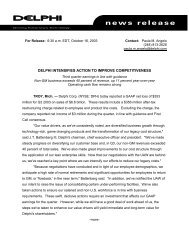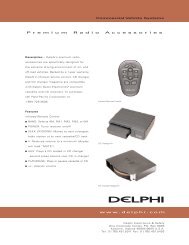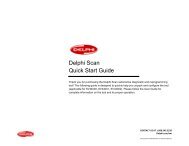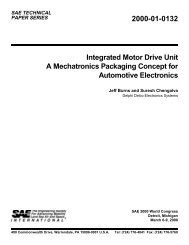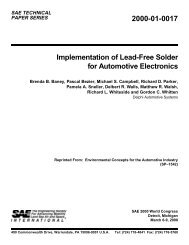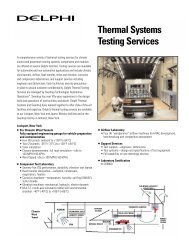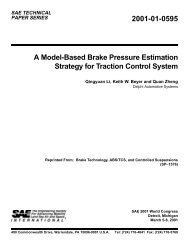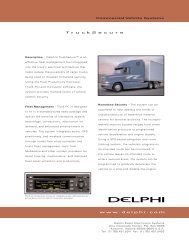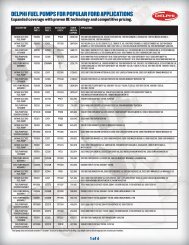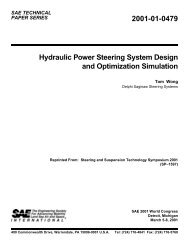2003-01-0954 Safety Belt Fit, Comfort, and Contact ... - Delphi
2003-01-0954 Safety Belt Fit, Comfort, and Contact ... - Delphi
2003-01-0954 Safety Belt Fit, Comfort, and Contact ... - Delphi
Create successful ePaper yourself
Turn your PDF publications into a flip-book with our unique Google optimized e-Paper software.
One objective of the study is to determine the shift in the<br />
contact pressure while changing the seat back angle <strong>and</strong><br />
the location of the seat belt upper attachment points (Dring)<br />
by utilizing a body pressure measurement system.<br />
Another is to identify how seat belt contact pressure <strong>and</strong><br />
fit affect users’ subjective feelings of comfort.<br />
METHOD<br />
Each participant was tested with 54 experimental<br />
scenarios to investigate the seat belt pressure levels, seat<br />
belt fit, <strong>and</strong> subjective comfort ratings resulting from<br />
various geometric configurations of the D-ring, seat back<br />
angles, <strong>and</strong> different anthropometric dimensions.<br />
SET-UP<br />
The set-up consists of a universal seating buck to<br />
simulate a passenger car interior package. The threepoint<br />
belt system was configured to represent an<br />
adjustable "D"-ring anchor with three different levels of<br />
seat back angle. Extra webbing was provided to allow<br />
measuring the seat belt comfort <strong>and</strong> fit for extreme<br />
geometric configurations. In addition, the seat was in a<br />
fixed position during the entire test.<br />
MEASUREMENTS<br />
Tekscan ISCAN V4.23 pressure measurement system<br />
was utilized to sample the pressure distribution on the<br />
seat belt. For convenience in describing the pressure<br />
distribution patterns, the pressure sensor with a resolution<br />
of 44 x 52 is virtually divided into 8 even segments.<br />
Segment number 1 to 8 indicate the relative seat belt<br />
portion from top of the shoulder to the buckle location<br />
(Figure 2). A Metrecom 3D Digitizer was also utilized to<br />
collect the participants’ 17 st<strong>and</strong>ard anthropometric<br />
measurements, e.g., st<strong>and</strong>ing height, seating height,<br />
shoulder width, etc.<br />
8: ASIS/Buckle<br />
4: Sternum<br />
6: Abdomen<br />
1: Top of Shoulder<br />
3: Upper Chest<br />
Figure 2. Seat <strong>Belt</strong> Segments Definition<br />
2<br />
TEST PARTICIPANTS<br />
A total of 15 volunteers, including 11 males <strong>and</strong> 4<br />
females, participated the test. Their height <strong>and</strong> Body<br />
Mass Index (BMI) data are summarized in Table 1.<br />
Table 1. Anthropometric Data for Test Subjects (N=15)<br />
Height (inch) BMI<br />
MEAN 68.48 25<br />
STDEV 3.20 6.50<br />
MAX 72.30 43<br />
MIN 61.70 17<br />
Table 2 lists the height <strong>and</strong> BMI in three categories:<br />
• 4 short stature females (66%-ile)<br />
Table 2. Grouping information for Test Participants<br />
BMI (Body<br />
Mass Index)<br />



